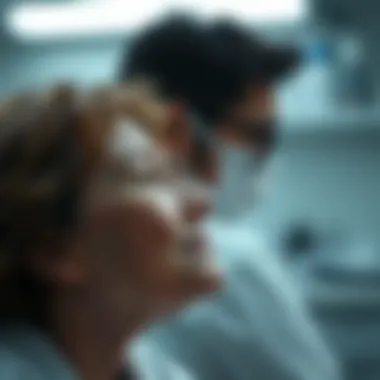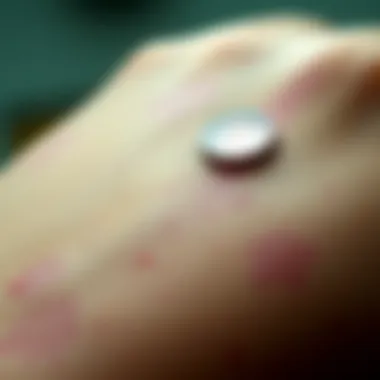Psoriasis and Lupus: Symptoms and Connections Explained


Intro
Understanding the relationship between psoriasis and lupus sheds light on two intricate autoimmune disorders that plague many individuals. Both conditions are linked by their chronic nature and can lead to significant distress, not just physically but also psychologically and socially.
Before diving into specific symptoms and their interplay, it is essential to clarify what these diseases entail. Awareness of the key concepts and terminologies surrounding psoriasis and lupus will provide much-needed context to appreciate the depth of patient experiences and the complexities that come with diagnosis and treatment.
Key Concepts and Terminology
Definition of Key Terms
- Psoriasis: A chronic skin disorder that causes rapid skin cell production, leading to thickened, red patches covered with silvery scales. This condition often manifests on elbows, knees, and the scalp but can affect any part of the body.
- Lupus: A systemic autoimmune disease that occurs when the body's immune system attacks its own tissues and organs. Lupus can affect the skin, joints, kidneys, and other organs, leading to a wide range of symptoms, including fatigue, joint pain, and skin rashes.
- Autoimmune Response: A reaction where the body's immune system mistakenly attacks healthy cells, resulting in inflammation and damage to bodily tissues.
Concepts Explored in the Article
This article examines several important concepts in relation to both psoriasis and lupus, such as:
- The symptom overlap between the two conditions, complicating diagnosis and management strategies.
- Personal anecdotes and patient narratives reflecting the day-to-day struggles faced by individuals coping with these disorders.
- The significance of recognizing not only the physical symptoms but also the emotional toll that living with psoriasis and lupus can incur.
- Considerations for healthcare professionals when diagnosing and treating patients with symptoms common to both conditions.
Findings and Discussion
Main Findings
Research reveals that around 30% of individuals diagnosed with psoriasis may experience symptoms related to psoriatic arthritis. Similarly, lupus can manifest with symptoms that resemble those of psoriasis, like rashes and skin lesions. The intersection of these symptoms poses a significant challenge for patients navigating their health journeys.
"It's a puzzle that often takes years to piece together, intertwining both conditions and leaving the patient in a fog until clarity is finally achieved."
Potential Areas for Future Research
Exploration of new biomarkers could lead to better diagnostic tools, while further studies on patient experiences can yield insights into tailored management approaches.
- The influence of genetics and environmental factors on the development of these autoimmune diseases.
- Psychological impacts of living with both psoriasis and lupus, and how best to support individuals in these situations.
- The effectiveness of current treatment options and how they impact the quality of life.
In wrapping up the findings, it becomes pressing to enhance the current understanding and recognition of these autoimmune diseases. As more research unfolds, we inch closer to a more detailed understanding of psoriasis and lupus, paving the way for more effective treatments and better patient care.
Foreword to Autoimmune Conditions
The realm of autoimmune conditions remains a complex landscape, highlighting the intriguing reality of the human immune system’s own antics, where it turns on itself, leading to a range of chronic diseases. Among the myriad of autoimmune disorders, psoriasis and lupus have gained significant attention due to their multifaceted symptoms and the profound effects they can have on an individual's health and overall quality of life. Understanding autoimmune conditions is crucial, as it opens avenues for better diagnosis and management, empowering patients and medical professionals alike.
Autoimmune diseases result from a miscommunication in the immune system, which starts attacking the body’s own cells, mistaking them for foreign invaders. This not only wreaks havoc on physical well-being, but can also deeply affect mental health and social interactions. For individuals living with conditions like psoriasis and lupus, the daily struggle can often feel overwhelming. They don’t just contend with physical symptoms; emotional and psychological tolls compound their experiences, creating barriers that go beyond mere physical health concerns.
Moreover, grasping the intricate nature of these conditions leads to a heightened awareness that is essential for support and advocacy. This is particularly pertinent given that many symptoms overlap between different autoimmune diseases, complicating diagnosis and prompt treatment. To add more nuance, the understanding of increased risk factors such as genetic predisposition alongside environmental triggers unveils a dimension that needs more discussions in both the medical community and in public forums.
In light of these complexities, the focus on autoimmune conditions cultivates a sense of community and understanding. It encourages research aimed at unraveling the enigma of these disorders, while also advocating for effective treatment modalities that address both physical symptoms and emotional resilience. Awareness, educational resources, and empathic discussions about autoimmune diseases can significantly influence how they are perceived and managed, leading to improved patient outcomes.
All in all, recognizing the significance of autoimmune conditions broadens our understanding, and most importantly, fosters a supportive environment for those affected. By connecting dots between various autoimmune diseases, this article aims to illuminate the complexities surrounding psoriasis and lupus, offering a comprehensive guide that speaks not only to patients, but also to healthcare professionals, educators, and researchers seeking to navigate these challenging terrains.
"Knowledge is power, and awareness is the key to effective disease management."
In this exploration, we will dive into the specificities of psoriasis and lupus, aiming to decode their symptoms, shared experiences, and the urgent need for accurate diagnosis rooted in a profound understanding of the broader spectrum of autoimmune conditions.
Understanding Psoriasis
Understanding psoriasis is critical when discussing autoimmune conditions like lupus. This skin ailment affects millions, yet remains a topic shrouded in misunderstanding. Natural thought might lead one to think psoriasis is just a skin issue, but it’s far more complex. It’s often tied not only to physical symptoms but also to emotional and mental health.
For individuals grappling with psoriasis, it’s crucial to have a grasp on its nature. This understanding helps in recognizing triggers, managing flare-ups, and communicating effectively with healthcare professionals. Knowledge leads to empowerment, a sense of control over one’s health journey. Here's why this topic deserves attention:
- Comprehensive Insight: Recognizing the multifaceted aspects of psoriasis allows for better management strategies and tailored treatment plans.
- Informed Discussions: Patients armed with knowledge can engage in more meaningful conversations with healthcare providers, ensuring their voices are heard.
- Awareness and Support: Educating oneself can foster a supportive community among those affected, offering shared strategies for coping.
By laying this foundation, we delve deeper into the specifics, examining various facets of psoriasis, its types, and the notable symptoms that patients endure.
Understanding Lupus
Lupus is a complex autoimmune disease, making its understanding crucial for anyone looking to navigate the challenges associated with it. Comprehending this condition not only enhances awareness, but also fosters empathy toward those dealing with its myriad effects. For many patients, lupus isn't just a medical issue; it impacts their daily lives, relationships, and mental well-being. Recognizing its symptoms can lead to earlier diagnosis and treatment, ultimately improving patient outcomes. When it comes to autoimmune diseases, knowledge is power.
What is Lupus?
Lupus is often described as a wolf in sheep’s clothing—a disease that can manifest in various ways, making diagnosis tricky. It primarily affects the immune system, where the body's defenses become misguided and start attacking healthy tissues. This results in inflammation, pain, and damage across various parts of the body, such as skin, joints, and organs. Symptoms often appear in flares, where they worsen before improving again, creating a fluctuating landscape of health. Understanding lupus requires a holistic view that incorporates medical factors, patient experiences, and the social implications of living with a chronic illness.
Forms of Lupus
Systemic Lupus Erythematosus
Systemic Lupus Erythematosus (SLE) is often deemed the most common and potentially serious form of lupus. What sets SLE apart is its ability to affect multiple organ systems, including the kidneys, heart, and nervous system, leading to a broad spectrum of symptoms. This characteristic makes understanding SLE vital for the overall conversation about lupus, as it illustrates how the disease doesn’t just affect surfaces but delves deep into bodily functions.
A unique feature of SLE is that it often presents with a distinct butterfly-shaped rash across the cheeks and nose, which many recognize as a hallmark of the disease. While SLE is particularly complex, leading to significant health challenges for patients, it also offers an extensive array of management and treatment options compared to other forms of lupus.
Discoid Lupus Erythematosus


Discoid Lupus Erythematosus (DLE) primarily manifests through skin lesions that may scab over and scar, usually localized to the face, neck, and scalp. Its presence marks a significant contribution to the overall topic as many may only experience this form without any systemic involvement. This localized nature might cause some to underestimate its impact; however, the aesthetic effects can be profound.
A key characteristic of DLE is that symptoms can improve significantly after sun exposure, a unique counterintuitive feature that warrants deeper exploration. Although DLE doesn't often involve internal organs, the psychosocial burden it carries can be just as heavy, emphasizing the need for comprehensive discussions on lupus.
Drug-Induced Lupus
In some cases, lupus may show up as a reaction to certain medications—this is known as Drug-Induced Lupus. Patients may find this form particularly intriguing because, unlike other types, it can often vanish once the offending drug is discontinued. Understanding this aspect of lupus helps highlight the interaction between medications and autoimmune responses, illustrating the nuanced relationship between pharmacology and autoimmune disorders. A key characteristic is the patient’s ability to return to baseline once the causative agent is removed, which often isn’t the case for other forms of lupus.
Nebulous Lupus
Nebulous Lupus may not refer to a well-defined category, but rather captures cases that don't fit neatly into established types of lupus. This can cause difficulty in diagnosis and treatment as the symptoms may fluctuate and evolve, leading healthcare providers and patients alike down a winding road of uncertainty. An intriguing aspect of Nebulous Lupus is its ability to transcend the traditional boundaries that define lupus, showcasing the diverse manifestations of autoimmune diseases. While it poses significant challenges, it serves as a reminder of the complexities inherent in medical classification.
Common Symptoms of Lupus
Fatigue
Fatigue is a major concern among those suffering from lupus and is not just your run-of-the-mill tiredness. Patients report profound exhaustion that can feel insurmountable, affecting various aspects of daily life like work and social interactions. It's essential to draw attention to this symptom because it underscores how the disease affects overall quality of life, not merely physical health. This unique feature shows that fatigue in lupus is often coupled with other compounded symptoms like pain or cognitive difficulties, which can lead to a complex interplay of challenges in managing health.
Joint Pain
Joint pain plagues many lupus patients, manifesting in various joints and resembling arthritis symptoms. The intensity can vary, sometimes flaring severely before subsiding. It’s vital to recognize that joint pain in lupus is often accompanied by swelling and stiffness—sometimes leading to mobility challenges. Highlighting this symptom not only aids in understanding the disease but also echoes the everyday difficulties faced by patients. The chronic nature of this discomfort can sometimes divert focus from other systemic issues at play, complicating treatment options.
Skin Rashes
Various skin rashes can appear in lupus patients, however, the most visually striking is often the aforementioned butterfly rash. Skin manifestations contribute significantly to the overall appearance and societal perceptions of those with lupus. This symptom is beneficial to address because it serves as a visible reminder of the disease’s impact, often garnering unhelpful attention or stigma from others. The complexity lies in the varying degrees of severity and visibility; not all individuals may show such obvious external signs, leading to an invisible burden for certain patients.
Fever
Fever can often be a silent alarm for those with lupus, serving as an indicator of underlying inflammation or flare-ups. Unlike a straightforward infection, the fever in lupus patients may fluctuate without an obvious cause. This characteristic makes it crucial for medical professionals to distinguish fever in lupus from other health conditions, emphasizing thorough diagnostic measures. Understanding this symptom matters; it can be a vital clue in the broader context of disease activity and management strategies.
Intersecting Symptoms of Psoriasis and Lupus
Understanding the intersection of symptoms between psoriasis and lupus is crucial for multiple reasons. Both conditions, while fundamentally different autoimmune diseases, share symptomatic similarities that can complicate diagnosis and treatment. Recognizing these overlapping symptoms can aid patients and healthcare providers in developing a comprehensive approach to managing these complexities. This section delves into dermatological and joint health issues that intertwine these conditions, illuminating the broader implications for individuals affected by both.
Shared Dermatological Symptoms
Skin Lesions and Rashes
The presence of skin lesions and rashes is one of the most common overlapping symptoms in psoriasis and lupus. In both diseases, these manifestations can vary in appearance and severity, which may confuse the diagnostic process. Psoriasis typically presents as thickened, red patches with silvery scales, while lupus rashes can take the form of a butterfly-shaped pattern across the face or other types of lesions on different body parts.
One key characteristic of these rashes is their response to various environmental factors. For instance, sunlight exposure can trigger a lupus rash, whereas psoriatic plaques may worsen in cold and dry conditions. Despite their differences, both conditions emphasize the need for vigilant skin care and awareness of triggers.
The unique feature of skin lesions in this context lies in the combination of their visibility and psychosocial impact. Visibility can lead to self-esteem issues, making the management of these symptoms not just a medical concern but a social one. Managing these skin manifestations can involve topical treatments, lifestyle adjustments, or behavioral therapies.
Changes in Nail Texture
Nail changes are another significant symptom linked to both psoriasis and lupus, particularly affecting how patients experience their autoimmune conditions. In psoriasis, nails may appear pitted, discolored, or separated from the nail bed, indicating a direct impact of the immune system on keratin production. In lupus, nail issues can manifest similarly but may also involve the skin around the nails, often leading to inflammation.
The key characteristic of changes in nail texture in the context of these two conditions is the potential for them to act as an outward sign of internal disease activity. For patients, these changes can be distressing. They serve as a daily reminder of the chronic nature of their illnesses.
As for its advantages and disadvantages, monitoring nail health can offer cues to underlying symptom control or flare-ups. On the flip side, persistent nail problems may lead to additional emotional strain, adding to the already considerable life changes faced by individuals living with autoimmune disorders.
Impact on Joint Health
Joint Swelling
Both lupus and psoriasis can lead to joint swelling, a symptom that not only indicates inflammation but can severely impede one’s quality of life. Psoriatic arthritis is specifically characterized by joint pain and swelling, which can arise from or coincide with skin manifestations. In lupus, joint swelling often reflects systemic activity of the disease, indicating a possible flare-up.
A notable characteristic of joint swelling in these conditions is its episodic nature. Patients may experience periods of exacerbation paired with symptom-free intervals, making it challenging to manage effectively. Understanding the patterns associated with such swelling can guide treatment and preventive strategies.
Joint swelling brings to light the unique feature of pain variability. While swelling is observable, the accompanying pain can vary widely between patients and sometimes is disproportionate to observable swelling, complicating treatment protocols.
Inflammatory Pain
When discussing inflammatory pain, both psoriasis and lupus present challenges that can overlap, yet are distinct in their origin and manifestation. This type of pain feels different than the general aches; it’s often sharp, severe, and associated with limited mobility. It presents a clinical challenge due to its impact on physical function and mental well-being.
The key characteristic of inflammatory pain in this scenario is its persistence. Unlike common soreness, this pain might not respond well to standard pain relievers, requiring specialized treatments. Those affected may find that management strategies differ from one condition to another, making it essential to tailor therapies to the individual's prevailing symptoms.
Moreover, inflammatory pain is particularly detrimental to daily life, impacting work and social interaction. This brings a dual advantage and disadvantage—while it signals potential disease activity, it can also serve to educate both patients and providers about the dynamics of their illnesses, enhancing overall understanding and fostering proactive healthcare planning.
Diagnosing Psoriasis and Lupus
Diagnosing psoriasis and lupus is a critical endeavor that involves a multifaceted approach, given the similarities and nuances of these autoimmune conditions. The importance lies not just in identifying the diseases but also in understanding their context within a patient’s overall health. An accurate diagnosis can significantly enhance the quality of life, guiding effective treatment strategies. It is crucial for healthcare professionals to differentiate between the two, as their management can diverge substantially.
In this section, we'll navigate the challenges faced in diagnosing these conditions, as well as the various diagnostic tests that can aid in clarity.
Challenges in Diagnosis
The journey toward a diagnosis of psoriasis or lupus often feels like navigating a maze. Patients frequently present with overlapping symptoms, which can lead to confusion, misdiagnosis, or even delays in receiving proper treatment. A common pitfall is the subjective nature of some symptoms; joint pain, for instance, can arise from conditions other than lupus or psoriatic arthritis.


Moreover, patients may not initially recognize subtle changes in their skin or joint health. They might attribute these symptoms to stress, aging, or various lifestyle factors, causing them to delay seeking medical advice. Such delays can prolong suffering, making the correct identification of symptoms critical.
Additionally, there are varying subtypes of both conditions, each exhibiting different clinical features. This variability can perplex even seasoned clinicians, who must balance thoroughness with time constraints in a busy practice.
Diagnostic Tests and Procedures
Blood Tests
Blood tests play a significant role in diagnosing both psoriasis and lupus. Common tests include antinuclear antibody testing for lupus and inflammatory markers that can suggest psoriatic arthritis. The key characteristic of these blood tests lies in their ability to reveal underlying immune system activity, offering insights into whether an autoimmune process is underway.
They are particularly beneficial due to their non-invasive nature and the broad range of information they can provide. However, it's essential to acknowledge that these tests may not be definitive. False positives can occur, requiring further investigation to confirm any findings.
Skin Biopsy
A skin biopsy is another critical tool in the diagnosis of psoriasis and lupus. This procedure involves taking a small sample of skin for microscopic examination, pinpointing specific characteristics that can distinguish between different conditions. The unique feature of skin biopsies is their ability to reveal cellular patterns and immune cell activity directly within the skin, offering a window into the disease's nature.
This method provides a definitive diagnosis, especially for distinguishing types of psoriasis or identifying discoid lupus lesions. However, some patients may find the procedure slightly uncomfortable, and results may take time, which can be frustrating when seeking immediate answers.
Imaging Techniques
Imaging techniques, such as X-rays or MRIs, are valuable, particularly for assessing joint involvement in psoriatic arthritis and lupus. These modalities can effectively illustrate any structural changes in the joints or inflammation present within body tissues.
Their characteristic strength lies in providing visual confirmation of symptoms, which can aid clinicians in determining the appropriate course of action. However, imaging can be resource-intensive and may not be available in all settings, potentially limiting accessibility for some patients.
Treatment Options for Psoriasis
Treating psoriasis is crucial not just for physical comfort but for a person's mental well-being. This chronic skin condition can affect how individuals perceive themselves and interact with others. With various treatment options available, understanding their roles can significantly help manage symptoms and improve quality of life. Let’s dive into the three main treatment categories available for managing psoriasis: topical treatments, phototherapy, and systemic treatments.
Topical Treatments
Topical treatments are usually the first line of defense against psoriasis. Applying medications directly to the affected areas helps reduce inflammation, limitations, and flaking. The specifics can vary based on the severity and type of psoriasis.
- Corticosteroids: Commonly used, these medications reduce inflammation and slow the rapid cell turnover associated with psoriasis. Different strengths are available, and healthcare providers might suggest potent options for severe cases.
- Vitamin D Analogues: Such as calcipotriene, these products slow skin cell growth and help in decreasing the plaques form. They are often used in combination with topical steroids for enhancing effectiveness.
- Retinoids: These vitamin A derivatives can help normalize skin cell growth. However, they may cause skin irritation, so they need to be used cautiously.
Important aspects to consider include the frequency of application and the potential side effects of these treatments. For many, consistent use of topical therapies can lead to significant improvements, though results may take time and patience.
Phototherapy
Phototherapy, or light therapy, is another effective treatment avenue for psoriasis, especially for moderate to severe cases. This approach utilizes ultraviolet (UV) light to decrease the rapid skin cell growth associated with psoriasis.
- UVB Phototherapy: Involves exposure to UVB light, which can significantly reduce plaques and decrease itchiness. This form of therapy can be performed in a dermatologist's clinic or at home using a special device designed for this purpose.
- PUVA Therapy: This combines a drug called psoralen with UVA light. Psoralen makes skin more sensitive to UV light, enhancing the treatment effects.
While phototherapy can be effective, it’s not without risks. Prolonged exposure may increase the risk of skin cancer. Thus, discussing the frequency and duration of treatments with a healthcare provider is critical.
Systemic Treatments
For those with severe psoriasis or when other treatments fail, systemic treatments come into play. These treatments impact the entire body and require a more comprehensive approach due to their potential side effects.
- Biologics: Target specific components of the immune system that drive inflammation in psoriasis. These are often considered for those with moderate to severe psoriasis who haven’t responded well to other treatments.
- Methotrexate: A longstanding systemic treatment that inhibits the immune response, effectively helping to control psoriasis. Regular blood tests may be necessary during treatment.
- Cyclosporine: This medication suppresses the immune response and delivers rapid results, but risks associated with long-term usage can be concerning.
Given the complexities of psoriasis, it is essential for individuals to work closely with healthcare professionals to identify the best treatment regimen tailored to their needs.
Understanding the options available allows individuals with psoriasis to make informed decisions, balancing the desired outcomes against potential side effects, thus fostering a more holistic approach to their health.
In summary, a combined approach utilizing the strengths of topical treatments, phototherapy, and systemic treatments often yields the best results for managing psoriasis. Staying informed about these options can significantly empower individuals to tackle their condition properly.
For further reading and resources on treatment options for psoriasis, one might consider visiting National Psoriasis Foundation and Mayo Clinic.
Treatment Options for Lupus
When delving into lupus, understanding the treatment options is critical. Lupus is a complex autoimmune condition, and its management often requires a multi-faceted approach. Not only does it aim to alleviate symptoms but also seeks to improve the quality of life for the individuals affected. Each treatment plan is tailored to the patient's specific needs, considering factors such as the type and severity of symptoms, overall health status, and any other underlying conditions.
Anti-inflammatory Medications
Anti-inflammatory medications are often the first line of defense for patients with lupus. These drugs play a significant role in managing the pain and swelling that can accompany lupus flares. Common medications in this category include nonsteroidal anti-inflammatory drugs (NSAIDs) such as ibuprofen and naproxen.
By reducing inflammation, these medications can alleviate joint pain and tenderness. For those who experience severe symptoms, corticosteroids may be prescribed. They are powerful anti-inflammatory agents that quickly control flares but come with a range of potential side effects.
It is vital for patients to be educated about the pros and cons of these medications. Regular monitoring by healthcare providers can help mitigate risks and ensure optimal outcomes.
Immunosuppressants
In more severe cases of lupus, immunosuppressants are often necessary. These drugs work by dampening the immune system's activity, which can prevent it from attacking the body's own tissues. Drugs like azathioprine, mycophenolate mofetil, and cyclophosphamide are commonly used.
- Benefits: The primary advantage of immunosuppressants is their effectiveness in controlling severe symptoms and preventing organ damage. This makes them crucial for patients whose lupus presents serious complications, such as nephritis, where the kidneys are affected.
- Considerations: However, there are notable considerations. Patients must be aware of their increased risk of infections, as the very nature of these medications weakens the immune response.
Working closely with specialists is important for monitoring the balance between managing disease activity and maintaining an acceptable level of immunity.
Biologic Therapies


Biologic therapies have emerged as a breakthrough in lupus treatment, particularly for patients who have not responded well to traditional therapies. These are drugs made from living organisms, as opposed to chemically synthesized medicines. Examples include belimumab and rituximab, which target specific pathways in the immune response.
- Advantages: Biologic therapies can be effective in reducing flare frequency and severity, providing a new avenue of hope for many. They can also be associated with fewer side effects compared to some traditional medications.
- Limitations: However, they are often costly and require careful selection of patients. Not everyone with lupus will be a candidate for biologics, and a thorough assessment is necessary.
In summary, treating lupus is not a simple one-size-fits-all scenario. Each patient’s journey with lupus is unique, so understanding and utilizing the right treatment options is key to managing this challenging condition. Specialists and healthcare providers play an invaluable role in guiding patients through their choices, ensuring they are well-informed and supported throughout their treatment journey.
"The road to managing lupus is long and can be filled with bumps, but with the right treatment options, individuals can find their way to a better quality of life."
For more information on lupus treatment and recent research trends, resources such as the Lupus Foundation of America and medical journals provide detailed insights.
Psychosocial Impacts of Psoriasis and Lupus
The burden of chronic conditions like psoriasis and lupus extends beyond physical symptoms. Understanding the psychosocial impacts these diseases have on individuals reveals a spectrum of emotional and social challenges. People often navigate a complex array of feelings, ranging from frustration and fatigue to isolation and anxiety. By shedding light on these aspects, the article emphasizes the importance of holistic care—treating not just the body but the mind and spirit as well.
Mental Health Considerations
The mental health implications of living with psoriasis and lupus can't be overstated. As individuals cope with the unpredictability of flare-ups, they may experience heightened levels of stress and anxiety. Research indicates that individuals with these autoimmune diseases can be at a higher risk for developing depression. The constant management of symptoms and the potential for lifelong treatment can lead to feelings of helplessness or low self-worth.
Understanding that these conditions are often visible can add another layer to mental health struggles. Social situations may become daunting, leading some individuals to avoid social outings altogether. The pressure to maintain a facade of normalcy can be overwhelming, potentially increasing feelings of loneliness and isolation. Examples of mental health considerations include:
- Anxiety about public appearance due to visible skin lesions.
- Fear of the future, worrying about disease progression.
- Social withdrawal, influenced by the physical limitations or visible symptoms of the conditions.
"Navigating life with autoimmune diseases means fighting battles that people can’t always see."
Social Stigma and Awareness
The stigmatization surrounding psoriasis and lupus can exacerbate psychological distress. Social stigma, often rooted in misconceptions and lack of understanding, creates barriers to acceptance and support. For example, misconceptions about psoriasis being contagious can lead to social isolation and poor self-esteem. The complexity of lupus, where symptoms may not be visibly obvious, often leaves patients questioning the sincerity of their experiences.
To combat these negative outcomes, awareness campaigns play a crucial role. Increased education about psoriasis and lupus can help dispel myths and promote empathy. Practical steps to enhance social awareness include:
- Community outreach programs that educate the public.
- Online forums and discussion groups, like those found on Reddit, where individuals can share their experiences and provide support.
- Collaborations with schools and workplaces to foster inclusive environments for those with visible and/or invisible symptoms.
In summary, recognizing the psychosocial dimensions of psoriasis and lupus is essential for comprehensive treatment. By promoting mental health support and raising awareness, society can create a more inclusive and understanding environment for those impacted by these conditions. This not only improves patient outcomes but also fosters a sense of community and belonging.
Research Trends and Future Directions
Research into psoriasis and lupus has gained momentum as understanding the complex interplay of these autoimmune conditions comes to the forefront. Both diseases present symptoms that can overlap, leading researchers to delve into avenues that might unveil clearer diagnostic criteria and more effective treatment modalities. Focusing on emerging therapies and genetic studies, this section explores the current state of research while also lining up potential paths for the future.
Emerging Therapies
New treatments are always on the horizon in both psoriasis and lupus research. The drive to improve patient quality of life has prompted the investigation into biologic therapies and new systemic medications.
Biologic therapies specifically are tailored to target the immune system pathways that become dysregulated in autoimmune disorders. For instance, medications like adalimumab or ustekinumab have shown promise in alleviating symptoms of psoriasis by blocking specific proteins that contribute to inflammation. Similarly, phase III clinical trials for lupus are examining drugs that involve monoclonal antibodies aimed to modulate immune responses. These therapies offer hope not only for symptom relief but potentially pave the way for disease modification.
"Innovations in treatment options continually evolve, reflecting the need for personalized and effective care in autoimmune diseases."
The fascinating part is the intertwining of research. For example, the responses seen in lupus patients with certain biologics have prompted researchers to ask whether similar pathways can be targeted in psoriasis management. This cross-pollination of information is vital as it accelerates the discovery of therapies that could alleviate or even modify disease progress in both conditions.
Genetic Studies
Genetic research has become the cornerstone of understanding the complexities behind autoimmune diseases like psoriasis and lupus. Investigating how specific genetic markers contribute to susceptibility and severity can offer insights unknown to traditional clinical approaches.
A significant number of studies focus on identifying single nucleotide polymorphisms (SNPs) that are common in individuals suffering from these conditions. For example, variations in genes like IL-23R and TNF might not only enhance one's risk for developing psoriasis but could also inform lupus susceptibility. This kind of knowledge could revolutionize patient care—leading to early diagnostics, tailored treatments, and even preventive strategies for individuals at high genetic risk.
The relationship between genetics and environmental factors is also gaining traction; how one’s lifestyle, exposure to sun, and stress levels can interact with these genetic markers presents a holistic view of the disease landscape.
Such research stands to improve public health strategies by highlighting the importance of genetic counseling and education in high-risk populations. Researchers are starting to understand that preventing the onset of these diseases might be as crucial as treating them.
Continued investment in genetic studies will not only bolster drug development but also refine our understanding of pathogenesis for both psoriasis and lupus.”
In summary, the future of psoriasis and lupus research is bright, with emerging therapies and genetic insights holding the promise of improved patient outcomes. As scientists unwrap the complexities woven within these autoimmune conditions, we glimpse a future where treatment is not just reactive but proactive and personalized. Investing in this research is not just an academic exercise; it resonates deeply with the lived experiences of those grappling with these conditions daily.
Finale
As we draw the curtain on this exploration of psoriasis and lupus, it becomes clear that understanding these two autoimmune conditions is not just important for patients, but for healthcare providers, educators, and the community at large. Each condition, while distinct in its own right, shares overlapping symptoms that can complicate diagnosis and treatment. Hence, raising awareness about their intersection is crucial for improving patient outcomes.
The challenges faced by individuals with psoriasis and lupus extend beyond physical symptoms—there are profound emotional and psychosocial implications as well. Conditions like these can lead to feelings of isolation and frustration, as individuals often navigate a world that is either misinformed about these diseases or outright indifferent.
Moreover, accurate diagnosis remains an uphill task for many due to the nuanced nature of symptoms that can vary significantly from one person to another. Here are several key takeaways that emphasize the significance of this topic:
- Intersectionality of Symptoms: Recognizing shared symptoms can lead to swifter, more effective treatment plans.
- Psychosocial Considerations: Awareness about mental health is vital as it can influence adherence to treatment protocols.
- Community Education: Teaching about these conditions can foster empathy and support among peers, reducing stigma.
In the intricate landscape of autoimmune diseases, knowledge stands as a beacon of hope. The more we learn about these conditions—how they manifest, how they intersect, and how we can support those afflicted—the better equipped we will be to provide necessary assistance and advocacy.
As healthcare continues to evolve, ongoing research and the pursuit of innovative treatments hold promise for alleviating the burdens of both psoriasis and lupus. For readers, whether patients, family members, or professionals, this understanding marks a pivotal step towards a future where autoimmune conditions are treated with the respect and insight they deserve.
"Knowledge is power, and awareness is the first step toward change."
Thus, as we conclude our insights into psoriasis and lupus, let it serve as a call to action—to deepen our understanding and foster compassion for those living with these chronic, intricate diseases.
For further information, consider visiting reputable resources:
- National Institute of Arthritis and Musculoskeletal and Skin Diseases
- American Academy of Dermatology
- Lupus Foundation of America
Together, with knowledge and awareness, we can turn the tide against the stigma and challenges posed by these autoimmune conditions.







